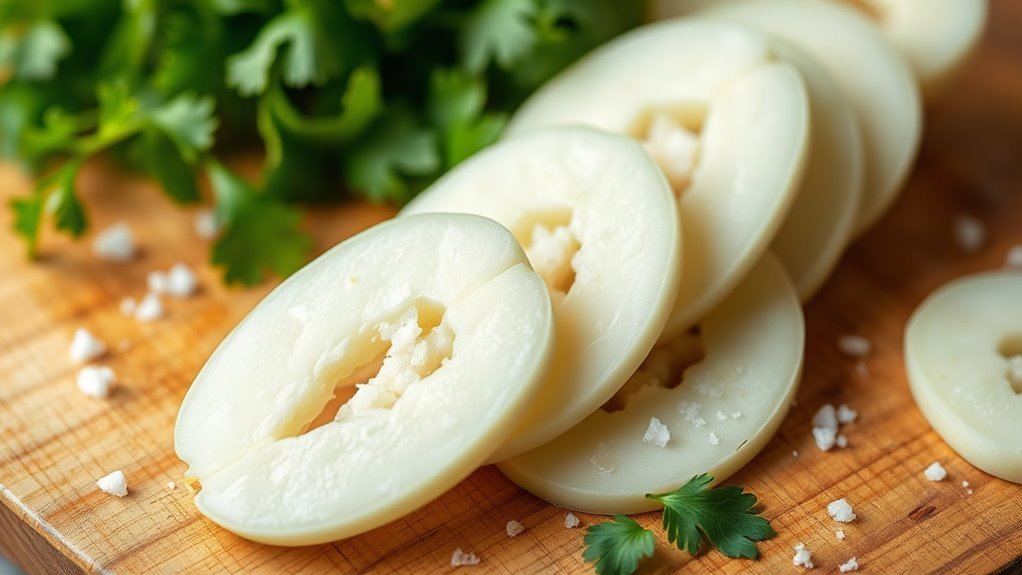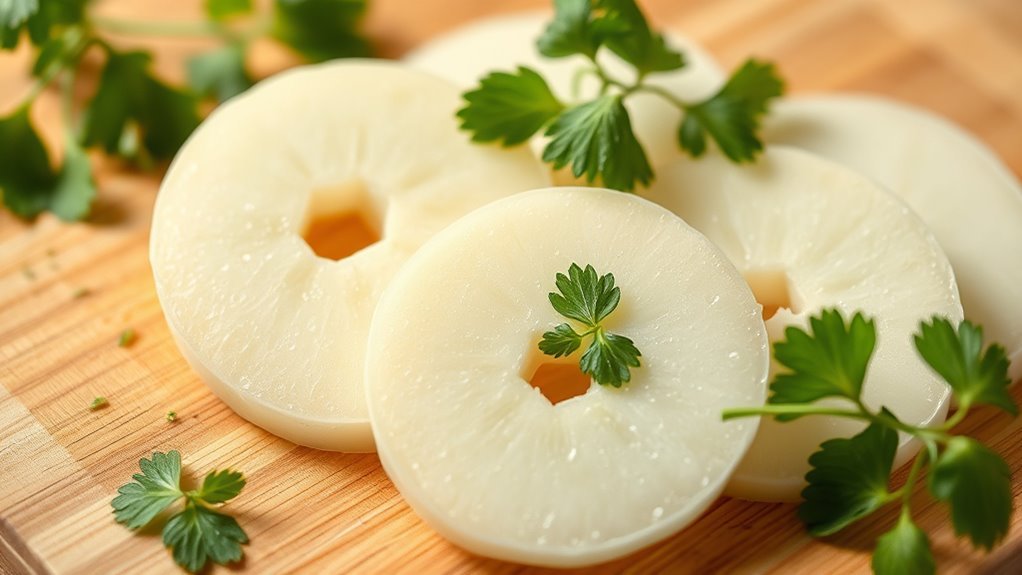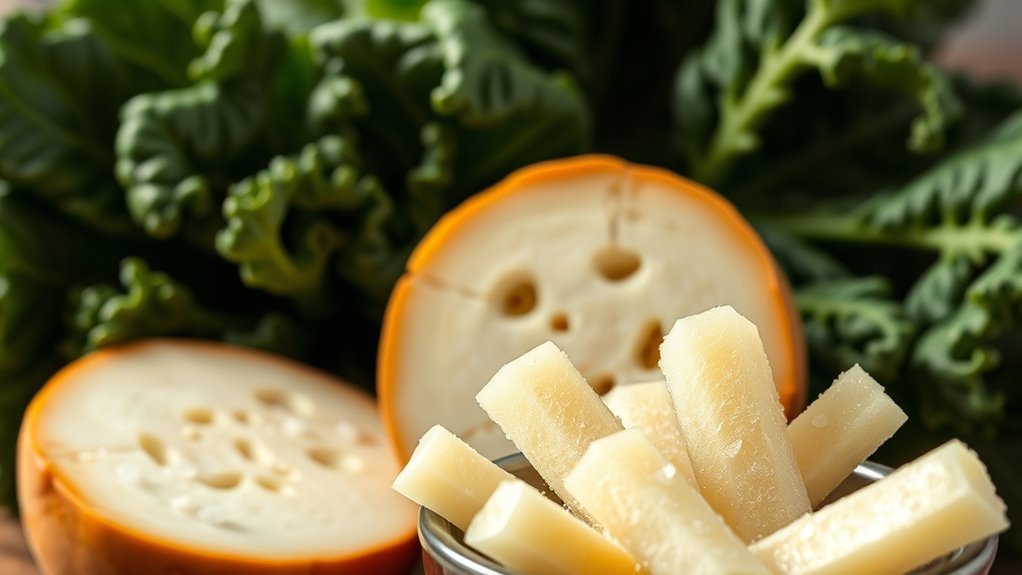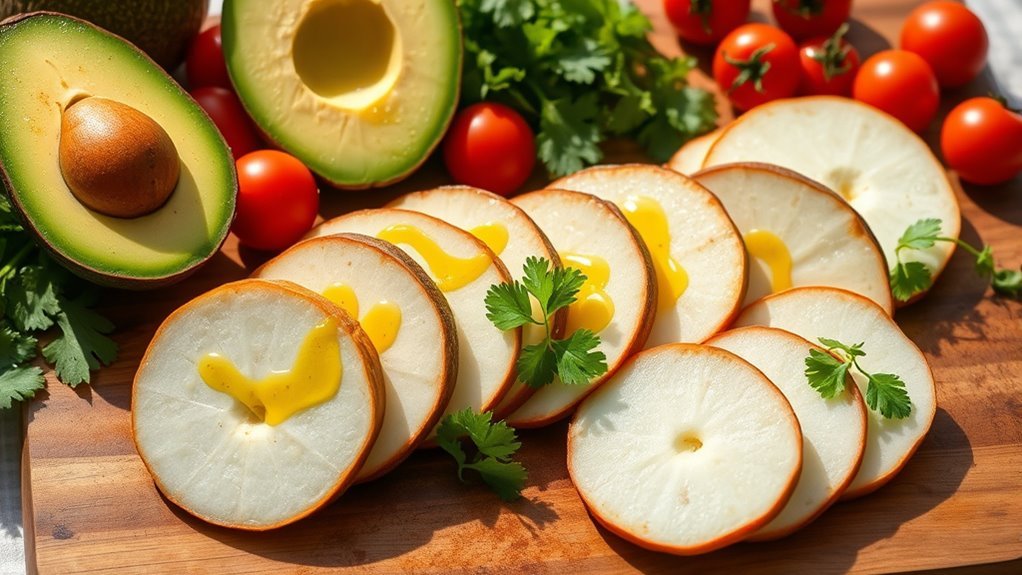Yes, jicama is generally considered keto-friendly. It has only about 9 grams of carbohydrates per 100g, primarily from fiber, making it a low-calorie option. Its high fiber content (4.9g) also contributes to a low glycemic index, which can stabilize energy levels. However, it’s important to monitor your portion sizes, as excess consumption might lead to digestive discomfort. If you want to explore more about its health benefits and how to incorporate jicama into your diet, there’s more to learn.
Understanding Jicama: An Overview

Although you might not be familiar with jicama, it’s a versatile root vegetable that’s gaining popularity for its crisp texture and mild flavor. Originally cultivated in Mexico, jicama has roots (literally) that trace back to the Aztecs. It’s often enjoyed raw, making it a great addition to salads and snacks. There are several jicama varieties, with the most common being the white-fleshed jicama that you’ll likely find in grocery stores. Each variety can offer a slightly different taste and texture; however, they all share the same invigorating crunch. As more people seek out healthy, low-calorie options, jicama’s unique characteristics make it an appealing choice for those looking to diversify their diet while enjoying its satisfying bite.
Nutritional Profile of Jicama

Jicama boasts an impressive nutritional profile that makes it a compelling choice for health-conscious individuals. Low in calories and high in fiber, it offers several jicama benefits, including promoting digestive health and aiding weight management. Incorporating jicama into your meals can enhance your diet with its crisp texture and mild flavor, perfect for various jicama recipes.
Here’s a quick look at its nutritional content per 100 grams:
| Nutrient | Amount | Daily Value (%) |
|---|---|---|
| Calories | 38 | 2 |
| Fiber | 4.9 g | 20 |
| Vitamin C | 20 mg | 33 |
With these attributes, jicama is a versatile addition to a balanced diet.
Carbohydrate Content and Ketogenic Diet

When considering a ketogenic diet, understanding the carbohydrate content of foods is vital for maintaining ketosis. Jicama, while low in calories, contains about 9 grams of carbohydrates per 100 grams, primarily from fiber, making it a unique option among carbohydrate sources. Its fiber content can be beneficial, allowing you to enjoy a crunchy texture without greatly impacting your carb intake. For those seeking keto substitutes for higher-carb foods, jicama can effectively replace potatoes in dishes like fries or salads. However, it’s important to monitor your overall carb consumption to stay within your daily limits. By carefully selecting low-carb foods like jicama, you can maintain freedom while enjoying diverse flavors on your keto journey.
Health Benefits of Jicama
Jicama is packed with essential nutrients, making it a highly nutrient-dense food choice. Its low glycemic index means it won’t spike your blood sugar, which is beneficial for maintaining stable energy levels. Incorporating jicama into your diet can provide various health advantages while supporting your keto lifestyle.
Nutrient Density Analysis
Root vegetables like jicama are packed with nutrients that offer several health benefits, making them a valuable addition to a balanced diet. When you look at a nutrient comparison, jicama stands out for its low calorie count and high fiber content, promoting digestive health.
Here’s a quick overview of jicama benefits:
| Nutrient | Amount per 100g | Health Benefit |
|---|---|---|
| Calories | 38 | Low-calorie option |
| Fiber | 4.9g | Aids digestion |
| Vitamin C | 20mg | Boosts immune function |
Including jicama in your meals not only enhances flavor but also contributes to your overall wellness, helping you meet your dietary goals without compromising on taste.
Low Glycemic Impact
Incorporating jicama into your diet not only boosts your nutrient intake but also offers a low glycemic impact, making it an excellent choice for those watching their blood sugar levels. With a glycemic index of just 15, jicama is classified as a low-GI food. This means it releases glucose slowly into your bloodstream, helping to maintain stable blood sugar levels. For individuals managing diabetes or following a ketogenic diet, this characteristic is essential. By adding jicama to meals, you can enjoy a satisfying crunch without the spikes in blood sugar that come from higher-GI options. Plus, its fiber content aids digestion, further supporting your health goals. Embrace jicama for a nutritious, blood sugar-friendly addition to your meals.
Ways to Incorporate Jicama Into Your Meals
When you’re looking to add a crunchy, low-carb element to your meals, jicama can be an excellent choice. You can create revitalizing jicama salads that combine it with greens and a zesty dressing. For a fun snack, try making jicama fries or chips, baked to perfection. Jicama wraps work beautifully as a low-carb alternative to tortillas for tacos or sandwiches. You can also whip up a jicama slaw to add to your dishes. If you’re in the mood for dips, jicama pairs well with various salsas. For a nutritious twist, consider adding jicama to smoothies or stir-fries. With these options, you can enjoy jicama’s versatility while staying on track with your keto lifestyle.
Potential Drawbacks of Eating Jicama on Keto
Although jicama is often praised for its low-carb content, there are potential drawbacks to evaluate when following a strict keto diet. While it can be a revitalizing addition, excessive jicama consumption might lead to issues such as digestive discomfort or an imbalance in your overall nutrient intake. Additionally, for those who are sensitive to high-fiber foods, jicama might not fit seamlessly into your meal plan.
| Nutrient | Jicama (100g) | Keto Limitations |
|---|---|---|
| Carbohydrates | 9g | May exceed daily carb limit |
| Fiber | 4g | Can cause digestive upset |
| Vitamins & Minerals | Moderate | Nutrient density may vary |
Keep these considerations in mind to stay aligned with your keto goals.
Final Thoughts on Jicama and a Keto Lifestyle
While jicama offers some appealing qualities for those on a keto diet, it’s crucial to weigh its benefits against potential drawbacks. Jicama is low in carbs and high in fiber, making it a suitable option for keto snacks. It can be a revitalizing addition to your meal plan, especially when used in jicama recipes like salads or as a crunchy dipper for low-carb sauces. However, some people may experience digestive discomfort due to its fiber content. It’s important to listen to your body and adjust accordingly. Ultimately, if you enjoy the taste and texture of jicama, it can certainly fit into a keto lifestyle—just be mindful of portion sizes and how it affects you personally.
Frequently Asked Questions
Is Jicama Safe for People With Diabetes?
Yes, jicama is generally safe for people with diabetes. It has a low glycemic index, which means it doesn’t spike your blood sugar levels like some other foods can. Incorporating jicama into your diet might help you manage blood sugar effectively. Its high fiber content also contributes to slower digestion, further stabilizing blood sugar. Just remember to monitor your overall carbohydrate intake to maintain a balanced approach to your meals.
Can You Eat Jicama Raw or Cooked?
You can definitely enjoy jicama both raw and cooked! Picture a crunchy, invigorating bite in a salad or a warm stir-fry; jicama brings versatility to your meals. Its benefits include being low in calories and high in fiber, making it perfect for healthy recipes. You might love trying jicama fries or adding it to tacos. Whichever way you choose, jicama’s unique taste and texture will enhance your dishes wonderfully!
How Does Jicama Compare to Other Low-Carb Vegetables?
Jicama stands out among low-carb vegetables due to its unique nutrition profile. It’s low in calories and high in fiber, which can help keep you full. Compared to others, jicama offers notable benefits like vitamin C and potassium. Its invigorating crunch makes it a versatile addition to salads or snacks. When considering low-carb options, jicama’s combination of hydration and nutrients can be a great choice for your healthy eating journey.
What Are the Best Ways to Store Jicama?
Jicama’s joyful journey starts with proper storage! To maintain jicama’s freshness, keep it in a cool, dark place, ideally in a paper bag to absorb moisture. If you’ve cut it, wrap it tightly in plastic wrap and refrigerate. For best jicama storage, avoid sealing it in airtight containers, as this can lead to spoilage. With these tips, you’ll enjoy crisp, crunchy jicama for your meals, maximizing its delightful taste!
Does Jicama Contain Any Allergens or Common Sensitivities?
Jicama allergies are quite rare, but some individuals may experience sensitivities to it. If you’ve got a history of food allergies, especially to legumes or other root vegetables, it’s wise to approach jicama cautiously. Symptoms can include digestive issues or skin reactions. Always consider trying a small amount first, and if you experience any adverse reactions, it’s best to avoid it. Always consult with a healthcare provider for personalized advice regarding food sensitivities.


